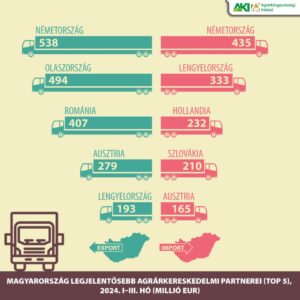Germany remains our most important agricultural foreign trade partner
Hungary conducted 87 percent of its agricultural foreign trade turnover with EU countries in 2024. The share of the old member states was 47.6 percent, and that of the new member states was 35.6 percent of the total agricultural foreign trade export. The value of agricultural exports to EU member states increased by 1.5 percent, and that of imports by 3.7 percent.

Agricultural foreign trade exports to third countries outside the European Union increased by 8.3 percent in 2024. The value of exports (1,614.2 million euros) decreased by 124 million euros, and the value of imports (457 million euros) decreased by 395.4 million euros compared to 2023. The surplus (1,157.2 million euros) was 518.9 million euros more than in the base year. The top five export markets – Germany (€1,919 million), Italy (€1,737 million), Romania (€1,593 million), Austria (€1,111 million) and Poland (€847 million) – together accounted for 52.5 percent of total agricultural exports in 2024 (Figure 8). Exports to Italy and Germany increased by 3.3–3.4 percent, while exports to Poland increased by 12.4 percent, while exports to Austria and Romania decreased by 3.3 and 4.1 percent, respectively. Among the ten most important export partners, exports to the United Kingdom increased the most (by 18.3 percent) compared to the previous year (Figure 9).
About four-fifths of agricultural imports came from ten countries (all of which were EU member states) in both 2023 and 2024 (Figure 10)
In terms of imports, the five most important partners – Germany (EUR 1,767 million), Poland (EUR 1,390 million), the Netherlands (EUR 925 million), Slovakia (EUR 865 million) and Austria (EUR 663 million) – accounted for 57.7 percent of the total agricultural import value in 2024. Among the key partner countries, the value of agricultural and food products shipped to Hungary from the given country typically increased by 2–23 percent, however, imports from Slovakia and Romania fell by 12.6 and 13 percent, respectively, while Austrian and Czech imports remained unchanged compared to the base period.
AKI PÁIR
Related news
AM: Government helps farmers with a loan moratorium
🎧 Hallgasd a cikket: Lejátszás Szünet Folytatás Leállítás Nyelv: Auto…
Read more >More than 100 Hungarian farmers also demonstrated in Brussels
🎧 Hallgasd a cikket: Lejátszás Szünet Folytatás Leállítás Nyelv: Auto…
Read more >NAK: Domestic producers await customers with an ample supply of all pine species
🎧 Hallgasd a cikket: Lejátszás Szünet Folytatás Leállítás Nyelv: Auto…
Read more >Related news
Christmas shock in commerce: for the first time, we can pay with bank cards in fewer places
🎧 Hallgasd a cikket: Lejátszás Szünet Folytatás Leállítás Nyelv: Auto…
Read more >Hungarian Confectionery Manufacturers Association: trends in 2025 and prospects for 2026
🎧 Hallgasd a cikket: Lejátszás Szünet Folytatás Leállítás Nyelv: Auto…
Read more >Most grocery chains will be open until noon on December 24th
🎧 Hallgasd a cikket: Lejátszás Szünet Folytatás Leállítás Nyelv: Auto…
Read more >






